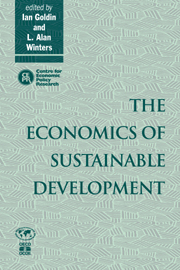Book contents
- Frontmatter
- Contents
- List of figures
- List of tables
- Preface
- Acknowledgements
- List of conference participants
- 1 Economic policies for sustainable development
- PART ONE GROWTH AND THE ENVIRONMENT
- PART TWO SUSTAINABILITY
- PART THREE DOMESTIC POLICY
- 7 Economic policies for sustainable resource use in Morocco
- Discussion
- 8 Energy pricing for sustainable development in China
- Discussion
- PART FOUR INTERNATIONAL POLICY COORDINATION
- Index
8 - Energy pricing for sustainable development in China
Published online by Cambridge University Press: 04 August 2010
- Frontmatter
- Contents
- List of figures
- List of tables
- Preface
- Acknowledgements
- List of conference participants
- 1 Economic policies for sustainable development
- PART ONE GROWTH AND THE ENVIRONMENT
- PART TWO SUSTAINABILITY
- PART THREE DOMESTIC POLICY
- 7 Economic policies for sustainable resource use in Morocco
- Discussion
- 8 Energy pricing for sustainable development in China
- Discussion
- PART FOUR INTERNATIONAL POLICY COORDINATION
- Index
Summary
As for many other developing countries, China's plans for economic growth are likely to be achieved only at the cost of a deteriorating environment. With population predicted to grow at over 1 percent p.a. until 2000 (Hull, 1991, table 5.4) and GNP per capita of US$370 p.a. in 1990, it is under pressure to raise living standards. From 1980 to 1990, GNP grew at an average of 9.5 percent p.a. (World Bank, 1992, table 2) and China expects to sustain its current high growth rate until 2000, by which time it would exceed its goal of quadrupling 1980 GDP (Gan Ziyu, Vice Minister of the State Planning Commission, Financial Times, 28 February 1993). To achieve this goal it plans to double production of coal, its major energy source.
China consumes nearly 9 percent of the world's commercial energy, which makes it the world's fourth largest consumer, exceeded only by the US consuming 25 percent, the Commonwealth of Independent States (CIS) 18 percent and the EC 15 percent. Energy consumption per capita is low, however, at 598 kg of oil equivalent, or about 38 percent of the world average (World Bank, 1992, table 5). Unlike most other large energy users, China relies heavily on coal which provides 76 percent of its current commercial energy needs. It is fortunate in having extensive reserves of coal, much of excellent quality and available at low cost, but their use brings many environmental costs. China is currently the world's third largest emitter of carbon dioxide and one of the largest sources of methane from fossil fuels (see table 8.1).
- Type
- Chapter
- Information
- The Economics of Sustainable Development , pp. 200 - 230Publisher: Cambridge University PressPrint publication year: 1995



